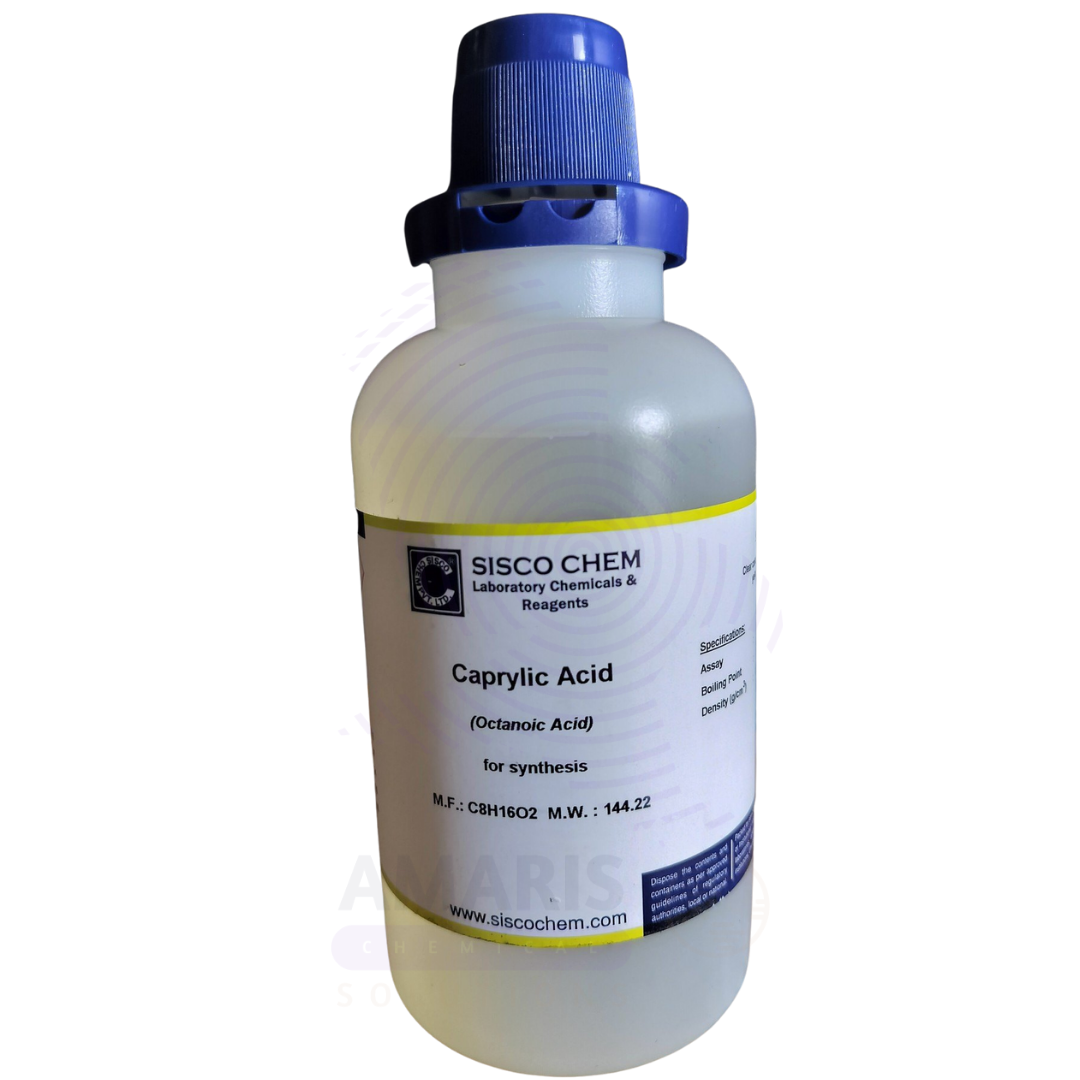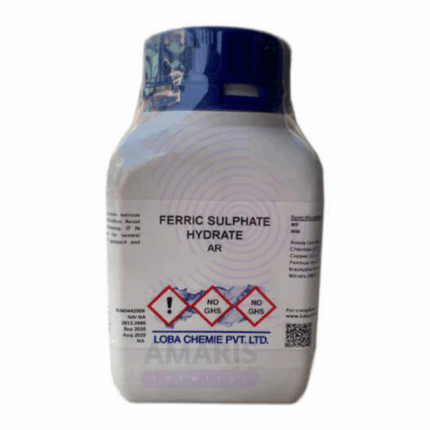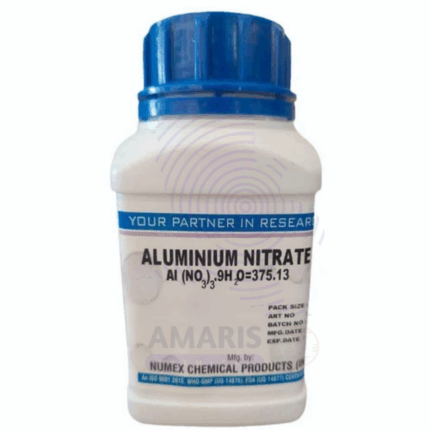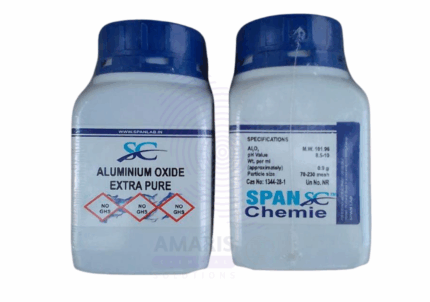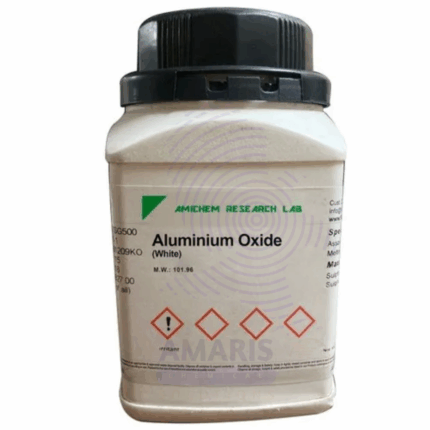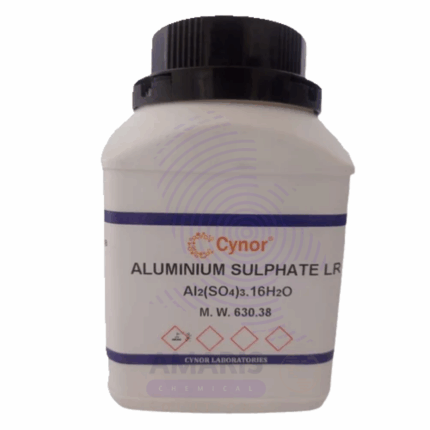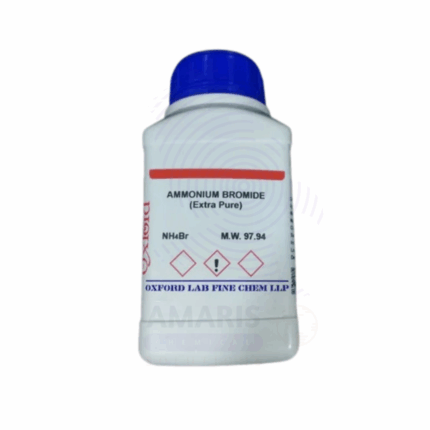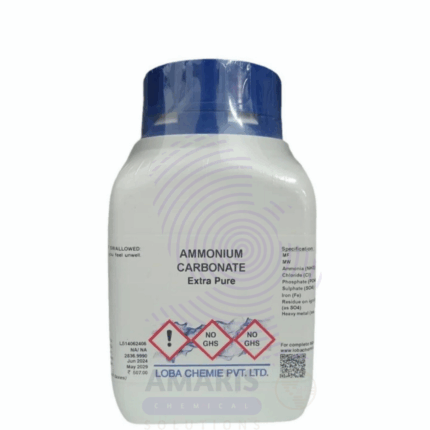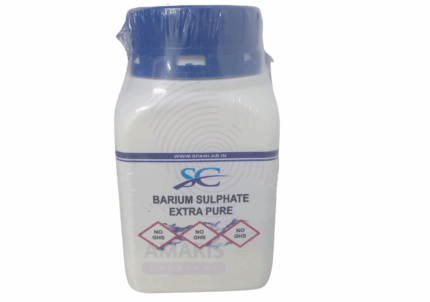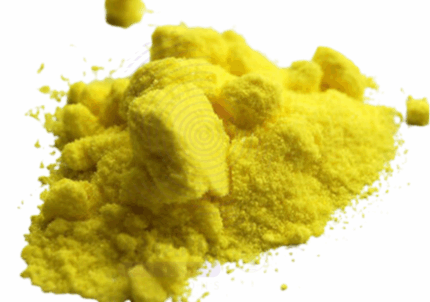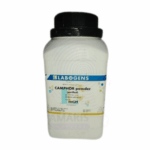

Caprylic/Capric Acid Extra Pure
$ 17.25 Original price was: $ 17.25.$ 17.18Current price is: $ 17.18.
Caprylic/Capric Acid Extra Pure is a high-purity blend of medium-chain saturated fatty acids—primarily octanoic (caprylic) and decanoic (capric) acids—used in laboratory environments for studying lipid chemistry, esterification, and antimicrobial properties. Its dual-chain composition makes it valuable for investigating emulsion systems, fatty acid metabolism, and as a reference standard in chromatographic analysis. This acid mixture is also employed in the synthesis of esters, surfactants, and as a model compound in solubility and partition coefficient experiments. The extra pure grade ensures minimal contamination, supporting consistent and accurate results in biochemical and organic chemistry applications. It should be stored in a cool, dry place in tightly sealed containers to maintain stability and prevent oxidation.
Caprylic/Capric Acid Extra Pure
Primary Uses
- Lipid and Fatty Acid Analysis
- Frequently used in chromatographic studies (e.g., GC, HPLC) as a standard or test compound for analyzing medium-chain fatty acids.
- Biochemical and Nutritional Research
- Studied for its metabolic behavior and role in energy metabolism, especially in research related to ketogenic diets or MCT (Medium Chain Triglyceride) formulations.
- Antimicrobial Activity Testing
- Used in microbiology labs to study its antibacterial and antifungal properties, especially against Candida species and Gram-positive bacteria.
- Solubility and Emulsification Studies
- Employed in emulsion experiments to examine miscibility, phase behavior, and stability of fatty acid-based systems.
Secondary Uses
- Cosmetic and Dermatological Research
- Studied as a component in topical formulations or for its role in skin absorption and carrier functions in cosmetic chemistry.
- Model Compound in Esterification Reactions
- Serves as a representative fatty acid in organic synthesis labs to explore esterification, transesterification, and saponification mechanisms.
- pH and Buffering Capacity Experiments
- Investigated in analytical setups for its acid dissociation behavior and buffering properties in various solvent systems.
- Toxicological Studies
- Sometimes used in in vitro studies to evaluate cellular responses or irritation potential of fatty acids.
| PACK SIZE |
500 grams Plastic Tin |
|---|
1. Basic Identification Attributes
- Chemical Name: Caprylic/Capric Acid (C8-C10 Fatty Acid Mixture)
- INCI Name: Caprylic/Capric Acid
- CAS Number:
- Caprylic Acid (Octanoic Acid): 124-07-2
- Capric Acid (Decanoic Acid): 334-48-5
- Grade: Extra Pure (Laboratory Grade)
- Molecular Formula:
- Caprylic: C₈H₁₆O₂
- Capric: C₁₀H₂₀O₂
- Synonyms: Octanoic/Decanoic Acid, Medium-Chain Fatty Acids (MCFAs)
2. Physical & Chemical Properties
- Appearance: Clear to pale yellow liquid
- Odor: Mild fatty or unpleasant acidic odor
- Molecular Weight:
- Caprylic Acid: 144.21 g/mol
- Capric Acid: 172.26 g/mol
- Melting Point:
- Caprylic: ~16.5 °C
- Capric: ~31.6 °C
- Boiling Point:
- Caprylic: ~239 °C
- Capric: ~268 °C
- Solubility: Insoluble in water; soluble in ethanol, chloroform, and oils
- Density: ~0.91 g/cm³
3. Safety & Hazard Attributes
- GHS Classification:
- Skin Corrosion/Irritation – Category 2
- Eye Irritation – Category 2A
- GHS Pictograms:
- Hazard Statements:
- H315: Causes skin irritation
- H319: Causes serious eye irritation
- Precautionary Statements:
- P280: Wear protective gloves/eye protection
- P302+P352: If on skin, wash with soap and water
- P305+P351+P338: If in eyes, rinse cautiously with water
4. Storage & Handling Attributes
- Storage Conditions:
- Store in a cool, well-ventilated place
- Keep container tightly sealed
- Protect from heat, moisture, and sunlight
- Handling Precautions:
- Avoid contact with eyes and skin
- Use in well-ventilated area or fume hood
5. Regulatory & Compliance Attributes
- Transport Classification: Not regulated as a hazardous material for transport
- Waste Disposal: Dispose of according to local environmental regulations
- REACH Status: Registered for industrial and laboratory use
6. Environmental & Health Impact
- Toxicity: Generally low toxicity but can cause irritation
- Environmental Impact: Biodegradable; minimal aquatic toxicity
- Fumes/Dusts: Not volatile at room temperature; minimal vapor hazard
SAFETY PRECAUTIONS
- Personal Protective Equipment (PPE):
- Wear safety goggles, nitrile or neoprene gloves, and a lab coat.
- Use respiratory protection in case of insufficient ventilation or mist formation.
- Handling:
- Handle in a well-ventilated area.
- Avoid inhalation, skin/eye contact, and prolonged exposure.
- Avoid formation of mist or aerosols.
- Storage:
- Store in a cool, dry, well-ventilated place.
- Keep the container tightly sealed and away from oxidizing agents and strong bases.
- Protect from moisture and direct sunlight.
FIRST AID MEASURES
- Inhalation:
- Move people to fresh air.
- If breathing is difficult, give oxygen.
- Seek medical attention if symptoms persist.
- Skin Contact:
- Wash with plenty of water and soap.
- Remove contaminated clothing.
- Seek medical attention if irritation occurs.
- Eye Contact:
- Rinse immediately with plenty of water for at least 15 minutes.
- Lift eyelids occasionally while flushing.
- Seek medical attention.
- Ingestion:
- Rinse mouth with water.
- Do not induce vomiting.
- Seek immediate medical help, especially if a large quantity is ingested.
FIRE FIGHTING MEASURES
- Flammability:
- May be combustible at high temperature.
- Can emit irritating fumes when burned.
- Extinguishing Media:
- Use foam, dry chemical powder, or carbon dioxide (CO₂).
- Avoid using water jets directly on the burning liquid.
- Hazardous Combustion Products:
- Produces carbon monoxide (CO) and carbon dioxide (CO₂) when combusted.
- Firefighter Protection:
- Wear self-contained breathing apparatus (SCBA) and chemical-resistant protective gear.
Related products
Aluminium Ferric Sulphate Extra Pure
Aluminium Nitrate Extra Pure
Aluminium Oxide Extra Pure
Aluminium Sulphate Anhydrous Extra Pure
Ammonium Bromide Extra Pure
Ammonium Carbonate Extra Pure
Ammonium Carbonate Extra Pure is a high-quality, white crystalline solid widely used across various scientific, industrial, and food-related applications. Manufactured to stringent purity standards, this compound is ideal for laboratories and processes that demand high-grade reagents. With its characteristic ammonia-like odor and ability to decompose upon heating, ammonium carbonate plays a versatile role in both chemical reactions and physical processes.
In aqueous solution, ammonium carbonate breaks down into ammonium bicarbonate and ammonium carbamate, further releasing ammonia (NH₃) and carbon dioxide (CO₂) upon heating. This property makes it especially useful in applications that require controlled gas release or temporary pH modification.


 Preservatives(food)
Preservatives(food) Flavor Enhancers
Flavor Enhancers Acidulants
Acidulants Sweeteners
Sweeteners Antioxidants
Antioxidants Colorants(food)
Colorants(food) Nutraceutical Ingredients (food)
Nutraceutical Ingredients (food) Nutrient Supplements
Nutrient Supplements Emulsifiers
Emulsifiers
 Collectors
Collectors Dust Suppressants
Dust Suppressants Explosives and Blasting Agents
Explosives and Blasting Agents Flocculants and Coagulants
Flocculants and Coagulants Frothers
Frothers Leaching Agents
Leaching Agents pH Modifiers
pH Modifiers Precious Metal Extraction Agents
Precious Metal Extraction Agents
 Antioxidants(plastic)
Antioxidants(plastic) Colorants (Pigments, Dyes)
Colorants (Pigments, Dyes) Fillers and Reinforcements
Fillers and Reinforcements Flame Retardants
Flame Retardants Monomers
Monomers Plasticizers
Plasticizers Polymerization Initiators
Polymerization Initiators Stabilizers (UV, Heat)
Stabilizers (UV, Heat)
 Antifoaming Agents
Antifoaming Agents Chelating Agents
Chelating Agents Coagulants and Flocculants
Coagulants and Flocculants Corrosion Inhibitors
Corrosion Inhibitors Disinfectants and Biocides
Disinfectants and Biocides Oxidizing Agents
Oxidizing Agents pH Adjusters
pH Adjusters Scale Inhibitors( water)
Scale Inhibitors( water)
 Antioxidants(cosmetic)
Antioxidants(cosmetic) Emollients
Emollients Fragrances and Essential Oils
Fragrances and Essential Oils Humectants
Humectants Preservatives
Preservatives Surfactants(cosmetic)
Surfactants(cosmetic) Thickeners
Thickeners UV Filters
UV Filters
 Fertilizers
Fertilizers Soil Conditioners
Soil Conditioners Plant Growth Regulators
Plant Growth Regulators Animal Feed Additives
Animal Feed Additives Biostimulants
Biostimulants Pesticides (Herbicides, Insecticides, Fungicides)
Pesticides (Herbicides, Insecticides, Fungicides)
 Active Pharmaceutical Ingredients (APIs)
Active Pharmaceutical Ingredients (APIs) Excipients
Excipients Solvents(pharmaceutical)
Solvents(pharmaceutical) Antibiotics
Antibiotics Antiseptics and Disinfectants
Antiseptics and Disinfectants Vaccine Adjuvants
Vaccine Adjuvants Nutraceutical Ingredients (pharmaceutical)
Nutraceutical Ingredients (pharmaceutical) Analgesics & Antipyretics
Analgesics & Antipyretics
 Analytical Reagents
Analytical Reagents Solvents(lab)
Solvents(lab) Chromatography Chemicals
Chromatography Chemicals Spectroscopy Reagents
Spectroscopy Reagents microbiology-and-cell-culture-reagents
microbiology-and-cell-culture-reagents Molecular Biology Reagents
Molecular Biology Reagents Biochemical Reagents
Biochemical Reagents Inorganic and Organic Standards
Inorganic and Organic Standards Laboratory Safety Chemicals
Laboratory Safety Chemicals Specialty Laboratory Chemicals(Special Laboratory Equipment)
Specialty Laboratory Chemicals(Special Laboratory Equipment)
 Demulsifiers
Demulsifiers Hydraulic Fracturing Fluids
Hydraulic Fracturing Fluids Scale Inhibitors(oil)
Scale Inhibitors(oil) Surfactants(oil)
Surfactants(oil) Drilling Fluids
Drilling Fluids
 Dyes and Pigments
Dyes and Pigments Bleaching Agents
Bleaching Agents Softening Agents
Softening Agents Finishing Agents
Finishing Agents Antistatic Agents
Antistatic Agents
 Admixtures
Admixtures Waterproofing Agents
Waterproofing Agents Sealants and Adhesives
Sealants and Adhesives Curing Compounds
Curing Compounds Concrete Repair Chemicals
Concrete Repair Chemicals Anti-Corrosion Coatings
Anti-Corrosion Coatings
 Surfactants(cleaning)
Surfactants(cleaning) Builders
Builders Enzymes
Enzymes Solvents (Cleaning)
Solvents (Cleaning) Fragrances
Fragrances
 Electronic Chemicals
Electronic Chemicals Catalysts
Catalysts Lubricants
Lubricants Photographic Chemicals
Photographic Chemicals Refrigerants
Refrigerants Automotive chemicals
Automotive chemicals Pyrotechnic Chemicals
Pyrotechnic Chemicals
 Biodegradable Surfactants
Biodegradable Surfactants Bio-based Solvents
Bio-based Solvents Renewable Polymers
Renewable Polymers Carbon Capture Chemicals
Carbon Capture Chemicals Wastewater Treatment Chemicals
Wastewater Treatment Chemicals
 Pigments
Pigments Solvents(paint)
Solvents(paint) Specialty Coatings
Specialty Coatings Binders/Resins
Binders/Resins Additives
Additives Driers
Driers Anti-Corrosion Agents
Anti-Corrosion Agents Functional Coatings
Functional Coatings Application-Specific Coatings
Application-Specific Coatings
 Fresh Herbs
Fresh Herbs Ground Spices
Ground Spices Whole Spices
Whole Spices Spice Blends
Spice Blends Dried Herbs
Dried Herbs
 Leavening Agents
Leavening Agents Dough Conditioners
Dough Conditioners Flour Treatments
Flour Treatments Fat Replacers
Fat Replacers Decoratives
Decoratives Preservatives(baking)
Preservatives(baking)
 Plasticizers & Softeners
Plasticizers & Softeners Reinforcing Agents
Reinforcing Agents Adhesion Promoters
Adhesion Promoters Vulcanizing Agents
Vulcanizing Agents Antidegradants
Antidegradants Blowing Agents
Blowing Agents Fillers & Extenders
Fillers & Extenders Accelerators & Retarders
Accelerators & Retarders